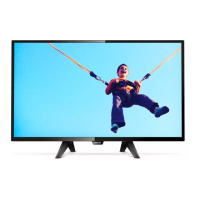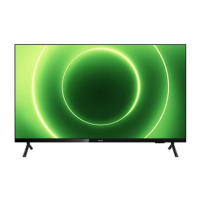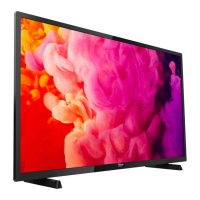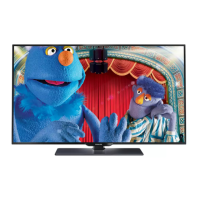Do you have a question about the Philips 32PHS5301 and is the answer not in the manual?
Connect to internet, discover new television features and online services.
Browse apps, discover tailored websites for TV, find missed programs, rent movies.
Pause and record broadcasts using a USB Hard Drive, watch later.
Use Philips TV Remote App for control, streaming, and scheduling.
Read safety instructions, tips on placement, and mounting guidance.
Proper connection of power, antenna, and satellite cables.
Connecting the TV to the internet via wired or wireless methods.
Wireless connection using WPS with PIN or button.
Troubleshooting common network connection issues.
Steps to establish a wired network connection.
Viewing and configuring network settings like static IP.
Enabling WoWLAN and Digital Media Renderer.
Activate Miracast for screen sharing from mobile devices.
Clear paired and blocked Miracast devices.
Clear internet data and enable file sharing.
Access Netflix settings and manage apps.
HDMI quality, ARC, and MHL mobile connection details.
Antenna port, set-top box connection, and HDCP.
Operate connected HDMI devices with the TV remote and compatibility.
Separately switching EasyLink remote control on/off.
Disabling picture processing on connected Philips devices.
Automatically switch off connected HDMI-CEC devices.
Connecting with component and composite video/audio cables.
Connecting for high-quality sound output via optical cable.
Using CI+ module for premium HD programs.
Inserting and using the CAM module and smart card.
Connecting set-top box and deactivating switch-off timer.
Connecting dish antenna cable to satellite receiver.
Connecting HTS via HDMI ARC and synchronizing audio/video.
Connecting HTS without HDMI ARC using optical cable.
Switching off TV's audio delay for HTS sync.
Setting TV delay and audio output format for HTS.
Adjusting volume levels and troubleshooting HTS sound problems.
Connecting smartphones/tablets wirelessly or via MHL.
Connecting Blu-ray and DVD players via HDMI.
Connecting game consoles via HDMI or component/CVBS.
Connecting headphones to the TV and adjusting volume.
Requirements for pausing/recording and steps to connect/format a USB drive.
Connecting and configuring USB keyboard layout.
Connecting and adjusting USB mouse speed.
Viewing photos, music, and videos from a USB flash drive.
Connecting photo cameras and camcorders.
Connecting a computer and setting optimal picture modes.
Turning the TV on, standby, and using TV buttons.
Setting sleep timer and deactivating switch off timer.
Overview of the remote control buttons and their functions.
Functions of specific remote control buttons.
IR sensor location and battery replacement.
Installing, updating, and reinstalling channels via antenna/cable.
Methods for switching channels and filtering lists.
Marking, watching, and setting up favorite channels.
Marking, unmarking, and reordering favorite channels.
Locking channels and setting age ratings for programs.
Accessing channel-specific options menu.
Setting subtitle languages and enabling display.
Manual subtitle setup for analogue channels.
Setting preferred audio and text languages.
Viewing CAM information and settings.
Navigating teletext and its various options.
Blocking HbbTV and selecting mono/stereo sound.
Setting text languages and activating Text 2.5.
Understanding interactive TV and HbbTV.
Switching on HbbTV and its prerequisites.
Accessing and navigating interactive TV pages.
Using digital text and closing iTV pages.
Requirements for TV Guide and data sources.
Opening, tuning, and navigating the TV Guide.
Viewing program details and changing guide days.
Setting reminders for program start times.
Searching by genre and scheduling recordings.
Canceling scheduled recordings.
Requirements and steps for recording programs.
Pausing and resuming live TV broadcasts.
Playing back recorded programs.
Information on recording status and potential failures.
Using instant replay and the playback progress bar.
Explanation of Home menu sections: Channels, Sources, Utilities, Quick Settings.
Steps to open the Home menu and select items.
Accessing Smart TV and the internet browser.
Accessing TV guide and recording program information.
Viewing channel list and updating TV software.
Viewing demonstration and available Net TV content.
Enjoying Netflix membership on the TV.
Switching between connected devices and tuners.
Setting specific options for TV inputs.
Rescanning connections to update the Sources menu.
Manually switching to ideal settings for gaming or computer.
Browsing the internet on the TV.
Viewing media files from USB drives and computers.
Navigating media files by type and sorting options.
Playing video files, controlling playback, and viewing info.
Adjusting video playback options like subtitles and shuffle.
Viewing photos and starting slideshows.
Playing music files and adjusting playback options.
Playing music during a photo slideshow.
Adjusting slideshow settings like speed and transition.
Using the Philips TV Remote App for TV control.
Enabling Wi-Fi Smart Screen for remote app features.
Activating Miracast and sharing device screen to TV.
Stopping screen sharing from TV or device.
Stopping screen sharing from the TV.
Blocking and unblocking devices in Miracast connections.
Connecting mobile devices via MHL for screen sharing and charging.
Discovering television via internet connection.
Requirements for using Smart TV apps.
Initial configuration and locking apps by age rating.
Accessing the Smart TV start page and app gallery.
Using the internet browser and searching the app gallery.
Adding and opening apps from the Smart TV start page.
Opening, closing, reloading, and zooming app pages.
Checking app security and providing feedback.
Removing, moving, and locking apps on the start page.
Renting movies, streaming video, and watching Online TV.
Viewing Online TV programs by broadcaster.
Watching TV channel in a small screen alongside Smart TV.
Resetting Smart TV connection and clearing internet memory.
Watching programs from another TV and its requirements.
Initial setup for Multi room.
Watching channels from another TV.
Changing the TV's network name.
Accessing quick settings like Eco, Picture, Sound, Clock.
Selecting and customizing picture styles.
Restoring picture styles to original settings.
Setting TV location and adjusting colour, contrast, sharpness.
Setting ideal picture modes for gaming/computer.
Enhancing colour and selecting colour temperatures.
Setting custom colour temperature and contrast modes.
Adjusting dynamic contrast, brightness, and video contrast.
Adjusting gamma and sharpness levels.
Reducing image noise and adjusting picture format.
Manually formatting the picture using zoom, stretch.
Reducing motion judder for smoother movement.
Choosing and restoring sound styles.
Adjusting bass, treble, and surround sound effects.
Automatically leveling sudden volume differences.
Adjusting volume leveling and controlling TV speakers.
Enhancing speech clarity and configuring audio output.
Adjusting audio delay and offset for HTS synchronization.
Adjusting headphone volume and TV placement sound.
Activating energy-saving features and screen off.
Deactivating automatic TV switch-off.
Configuring clock, sleep timer, and switch off timer.
Configuring EasyLink and Home/Shop location modes.
Setting up USB peripherals and TV Guide.
Managing channel logos and reinstalling the TV.
Copying channel lists and managing HbbTV settings.
Resetting to factory settings and copying satellite lists.
Configuring CAM settings and universal access features.
Setting parental ratings and managing Child Lock PIN codes.
Changing menu language and setting audio preferences.
Setting subtitle and text languages.
Navigating teletext and its various options.
Using interactive TV, HbbTV, and digital text.
Setting text languages and activating Text 2.5.
Setting TV clock automatically, manually, and time zone.
Enabling Universal Access features.
Enabling accessibility and hearing impaired features.
Enabling audio description and selecting commentary output.
Adjusting commentary volume with normal audio.
Switching on audio effects and speech subtitles for commentary.
Information on connecting the TV to a network.
Installing, updating, and reinstalling channels via antenna/cable.
Accessing digital TV settings.
Options for searching analogue, free/scrambled, and digital channels.
Configuring network frequency search modes and scan methods.
Checking signal quality and repositioning antenna.
Manually installing analogue channels.
Information on satellite tuners and starting the installation process.
Using Unicable systems and MDU support.
Changing satellite installation settings.
Managing user bands, adding, and removing satellites.
Understanding channel packages and restoring missing channels.
Setting up Unicable systems and assigning user bands.
Adjusting expert settings for transponder, LNB, and frequency.
Using CAM modules for satellite channels.
Manually installing channels from a transponder.
Reordering channels in the Favourites list.
Renaming channels in the channel list.
Troubleshooting satellite detection, reception, and missing channels.
Overview and prerequisites for copying channel lists.
Copying the current channel list to a USB drive.
Uploading channel list to a TV (new or existing).
Updating TV software via internet connection or USB.
Viewing software version and searching for local/OAD updates.
Information on open source software components and their licenses.
Energy efficiency rating and product fiche details.
Disposal guidelines and power specifications.
TV reception capabilities, screen size, and resolution.
Supported input resolutions and physical dimensions/weight.
List of connectivity ports and sound specifications.
Supported connections, file formats, codecs, and limitations.
Registering TV benefits and navigating the help system.
Solving TV power and remote control problems.
Troubleshooting missing digital channels during installation.
Troubleshooting no picture, distorted picture, and sound problems.
Troubleshooting HDMI and USB connection/playback issues.
Troubleshooting Wi-Fi connection problems.
Resolving internet connection and DHCP issues.
Changing the TV menu language back to preferred.
Accessing Philips online support and contacting customer care.
General safety rules and securing TV against falling.
Precautions against electric shock, fire, and injury.
Measures to ensure child safety and prevent overheating.
Safety regarding lightning, hearing, temperature, and humidity.
Guidelines for cleaning and maintaining the TV screen.
Legal terms, warranty conditions, and pixel characteristics.
Compliance with EU directives and EMF standards.
Trademarks for various technologies.
Information on Microsoft technologies used.
Trademarks and software copyright details.
Mention of other registered and unregistered trademarks.
Connect to internet, discover new television features and online services.
Browse apps, discover tailored websites for TV, find missed programs, rent movies.
Pause and record broadcasts using a USB Hard Drive, watch later.
Use Philips TV Remote App for control, streaming, and scheduling.
Read safety instructions, tips on placement, and mounting guidance.
Proper connection of power, antenna, and satellite cables.
Connecting the TV to the internet via wired or wireless methods.
Wireless connection using WPS with PIN or button.
Troubleshooting common network connection issues.
Steps to establish a wired network connection.
Viewing and configuring network settings like static IP.
Enabling WoWLAN and Digital Media Renderer.
Activate Miracast for screen sharing from mobile devices.
Clear paired and blocked Miracast devices.
Clear internet data and enable file sharing.
Access Netflix settings and manage apps.
HDMI quality, ARC, and MHL mobile connection details.
Antenna port, set-top box connection, and HDCP.
Operate connected HDMI devices with the TV remote and compatibility.
Separately switching EasyLink remote control on/off.
Disabling picture processing on connected Philips devices.
Automatically switch off connected HDMI-CEC devices.
Connecting with component and composite video/audio cables.
Connecting for high-quality sound output via optical cable.
Using CI+ module for premium HD programs.
Inserting and using the CAM module and smart card.
Connecting set-top box and deactivating switch-off timer.
Connecting dish antenna cable to satellite receiver.
Connecting HTS via HDMI ARC and synchronizing audio/video.
Connecting HTS without HDMI ARC using optical cable.
Switching off TV's audio delay for HTS sync.
Setting TV delay and audio output format for HTS.
Adjusting volume levels and troubleshooting HTS sound problems.
Connecting smartphones/tablets wirelessly or via MHL.
Connecting Blu-ray and DVD players via HDMI.
Connecting game consoles via HDMI or component/CVBS.
Connecting headphones to the TV and adjusting volume.
Requirements for pausing/recording and steps to connect/format a USB drive.
Connecting and configuring USB keyboard layout.
Connecting and adjusting USB mouse speed.
Viewing photos, music, and videos from a USB flash drive.
Connecting photo cameras and camcorders.
Connecting a computer and setting optimal picture modes.
Turning the TV on, standby, and using TV buttons.
Setting sleep timer and deactivating switch off timer.
Overview of the remote control buttons and their functions.
Functions of specific remote control buttons.
IR sensor location and battery replacement.
Installing, updating, and reinstalling channels via antenna/cable.
Methods for switching channels and filtering lists.
Marking, watching, and setting up favorite channels.
Marking, unmarking, and reordering favorite channels.
Locking channels and setting age ratings for programs.
Accessing channel-specific options menu.
Setting subtitle languages and enabling display.
Manual subtitle setup for analogue channels.
Setting preferred audio and text languages.
Viewing CAM information and settings.
Navigating teletext and its various options.
Blocking HbbTV and selecting mono/stereo sound.
Setting text languages and activating Text 2.5.
Understanding interactive TV and HbbTV.
Switching on HbbTV and its prerequisites.
Accessing and navigating interactive TV pages.
Using digital text and closing iTV pages.
Requirements for TV Guide and data sources.
Opening, tuning, and navigating the TV Guide.
Viewing program details and changing guide days.
Setting reminders for program start times.
Searching by genre and scheduling recordings.
Canceling scheduled recordings.
Requirements and steps for recording programs.
Pausing and resuming live TV broadcasts.
Playing back recorded programs.
Information on recording status and potential failures.
Using instant replay and the playback progress bar.
Explanation of Home menu sections: Channels, Sources, Utilities, Quick Settings.
Steps to open the Home menu and select items.
Accessing Smart TV and the internet browser.
Accessing TV guide and recording program information.
Viewing channel list and updating TV software.
Viewing demonstration and available Net TV content.
Enjoying Netflix membership on the TV.
Switching between connected devices and tuners.
Setting specific options for TV inputs.
Rescanning connections to update the Sources menu.
Manually switching to ideal settings for gaming or computer.
Browsing the internet on the TV.
Viewing media files from USB drives and computers.
Navigating media files by type and sorting options.
Playing video files, controlling playback, and viewing info.
Adjusting video playback options like subtitles and shuffle.
Viewing photos and starting slideshows.
Playing music files and adjusting playback options.
Playing music during a photo slideshow.
Adjusting slideshow settings like speed and transition.
Using the Philips TV Remote App for TV control.
Enabling Wi-Fi Smart Screen for remote app features.
Activating Miracast and sharing device screen to TV.
Stopping screen sharing from TV or device.
Stopping screen sharing from the TV.
Blocking and unblocking devices in Miracast connections.
Connecting mobile devices via MHL for screen sharing and charging.
Discovering television via internet connection.
Requirements for using Smart TV apps.
Initial configuration and locking apps by age rating.
Accessing the Smart TV start page and app gallery.
Using the internet browser and searching the app gallery.
Adding and opening apps from the Smart TV start page.
Opening, closing, reloading, and zooming app pages.
Checking app security and providing feedback.
Removing, moving, and locking apps on the start page.
Renting movies, streaming video, and watching Online TV.
Viewing Online TV programs by broadcaster.
Watching TV channel in a small screen alongside Smart TV.
Resetting Smart TV connection and clearing internet memory.
Watching programs from another TV and its requirements.
Initial setup for Multi room.
Watching channels from another TV.
Changing the TV's network name.
Accessing quick settings like Eco, Picture, Sound, Clock.
Selecting and customizing picture styles.
Restoring picture styles to original settings.
Setting TV location and adjusting colour, contrast, sharpness.
Setting ideal picture modes for gaming/computer.
Enhancing colour and selecting colour temperatures.
Setting custom colour temperature and contrast modes.
Adjusting dynamic contrast, brightness, and video contrast.
Adjusting gamma and sharpness levels.
Reducing image noise and adjusting picture format.
Manually formatting the picture using zoom, stretch.
Reducing motion judder for smoother movement.
Choosing and restoring sound styles.
Adjusting bass, treble, and surround sound effects.
Automatically leveling sudden volume differences.
Adjusting volume leveling and controlling TV speakers.
Enhancing speech clarity and configuring audio output.
Adjusting audio delay and offset for HTS synchronization.
Adjusting headphone volume and TV placement sound.
Activating energy-saving features and screen off.
Deactivating automatic TV switch-off.
Configuring clock, sleep timer, and switch off timer.
Configuring EasyLink and Home/Shop location modes.
Setting up USB peripherals and TV Guide.
Managing channel logos and reinstalling the TV.
Copying channel lists and managing HbbTV settings.
Resetting to factory settings and copying satellite lists.
Configuring CAM settings and universal access features.
Setting parental ratings and managing Child Lock PIN codes.
Changing menu language and setting audio preferences.
Setting subtitle and text languages.
Navigating teletext and its various options.
Using interactive TV, HbbTV, and digital text.
Setting text languages and activating Text 2.5.
Setting TV clock automatically, manually, and time zone.
Enabling Universal Access features.
Enabling accessibility and hearing impaired features.
Enabling audio description and selecting commentary output.
Adjusting commentary volume with normal audio.
Switching on audio effects and speech subtitles for commentary.
Information on connecting the TV to a network.
Installing, updating, and reinstalling channels via antenna/cable.
Accessing digital TV settings.
Options for searching analogue, free/scrambled, and digital channels.
Configuring network frequency search modes and scan methods.
Checking signal quality and repositioning antenna.
Manually installing analogue channels.
Information on satellite tuners and starting the installation process.
Using Unicable systems and MDU support.
Changing satellite installation settings.
Managing user bands, adding, and removing satellites.
Understanding channel packages and restoring missing channels.
Setting up Unicable systems and assigning user bands.
Adjusting expert settings for transponder, LNB, and frequency.
Using CAM modules for satellite channels.
Manually installing channels from a transponder.
Reordering channels in the Favourites list.
Renaming channels in the channel list.
Troubleshooting satellite detection, reception, and missing channels.
Overview and prerequisites for copying channel lists.
Copying the current channel list to a USB drive.
Uploading channel list to a TV (new or existing).
Updating TV software via internet connection or USB.
Viewing software version and searching for local/OAD updates.
Information on open source software components and their licenses.
Energy efficiency rating and product fiche details.
Disposal guidelines and power specifications.
TV reception capabilities, screen size, and resolution.
Supported input resolutions and physical dimensions/weight.
List of connectivity ports and sound specifications.
Supported connections, file formats, codecs, and limitations.
Registering TV benefits and navigating the help system.
Solving TV power and remote control problems.
Troubleshooting missing digital channels during installation.
Troubleshooting no picture, distorted picture, and sound problems.
Troubleshooting HDMI and USB connection/playback issues.
Troubleshooting Wi-Fi connection problems.
Resolving internet connection and DHCP issues.
Changing the TV menu language back to preferred.
Accessing Philips online support and contacting customer care.
General safety rules and securing TV against falling.
Precautions against electric shock, fire, and injury.
Measures to ensure child safety and prevent overheating.
Safety regarding lightning, hearing, temperature, and humidity.
Guidelines for cleaning and maintaining the TV screen.
Legal terms, warranty conditions, and pixel characteristics.
Compliance with EU directives and EMF standards.
Trademarks for various technologies.
Information on Microsoft technologies used.
Trademarks and software copyright details.
Mention of other registered and unregistered trademarks.
| Screen Size | 32 inches |
|---|---|
| Resolution | 1366 x 768 pixels |
| Display Technology | LED |
| Smart TV | Yes |
| HDMI Ports | 2 |
| USB Ports | 1 |
| HD type | HD Ready |
| Screen shape | Flat |
| Refresh Rate | 60 Hz |
| Built-in Wi-Fi | Yes |
| Digital signal format system | DVB-T/T2/C |
| VESA mounting | 100 x 100 mm |











